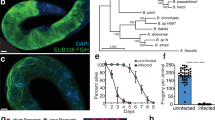Abstract
Trimmatostroma abietis initially grew as hyphae when grown in various media containing yeast extract or bactopeptone. It grew as segmented elements (lumbricoid elements) characterized by bidirectional growth, when grown in Czapek-Dox broth or yeast nitrogen base supplemented with 1% glucose. A lumbricoid element usually was 10–70 μm in length, with transverse septation only and contained 3 to 15 cells. Growth and propagation, as revealed by time-lapse photomicrography occurred as follows. Elements usually grew by apical elongation without widening; after simple apical elongation adjacent parts of two central cells eventually started to grow, resulting in the separation of the element into two.
Similar content being viewed by others
References
Butin, H, Pehl, L, de Hoog, GS & Wollenzien, U (1996) Trimmatostroma abietis sp. nov (Hyphomycetes) and related species. Antonie van Leeuwenhoek 69: 203–209 (this issue)
Gooday, GW & Gow, NAR (1990) Enzymology of tip growth in fungi. In: Tip growth in plant and fungal cells. Academic Press, London
Gow, NAR & Gooday, GW (1982) Vacuolation, branch production and linear growth of germ tubes of Candida albicans. J. Gen. Microbiol. 128: 2195–2198
Gustafson, RA, Hardcastle, RV and Szaniszlo, PJ (1975) Budding in the dimorphic fungus Cladosporium werneckii. Mycologia 67: 942–951
Henssen, A (1987) Lichenothelia, a genus of microfungi on rocks. Bibl. Lichenol. 25: 257–293
Mitchison, JM (1970) Physiological and cytological methods for Schizosaccharomyces pombe. Methods Cell Physiol. 4: 131–165
Staley, JT, Palmer, F & Adams, JB (1982) Microcolonial fungi: Common inhabitants on desert rocks? Science 215: 1093–1095
Shepherd, MG (1988) Morphogenetic transformation of fungi. In: McGinnis, MR (Ed) Current topics in medical mycology, II pp. 278–304. Springer-Verlag, New York
Szaniszlo, PJ, Jacobs, WJ & Geis, PA (1983) Dimorphism: Morphological and biochemical aspects. In: Howard, DH (Ed) Fungi pathogenic for humans and animals, A pp. 323–436. Marcel Dekker, New York
Author information
Authors and Affiliations
Rights and permissions
About this article
Cite this article
Yoshida, S., Takeo, K., De Hoog, G.S. et al. A new type of growth exhibited by Trimmatostroma abietis . Antonie van Leeuwenhoek 69, 211–215 (1996). https://doi.org/10.1007/BF00399608
Received:
Accepted:
Issue Date:
DOI: https://doi.org/10.1007/BF00399608




